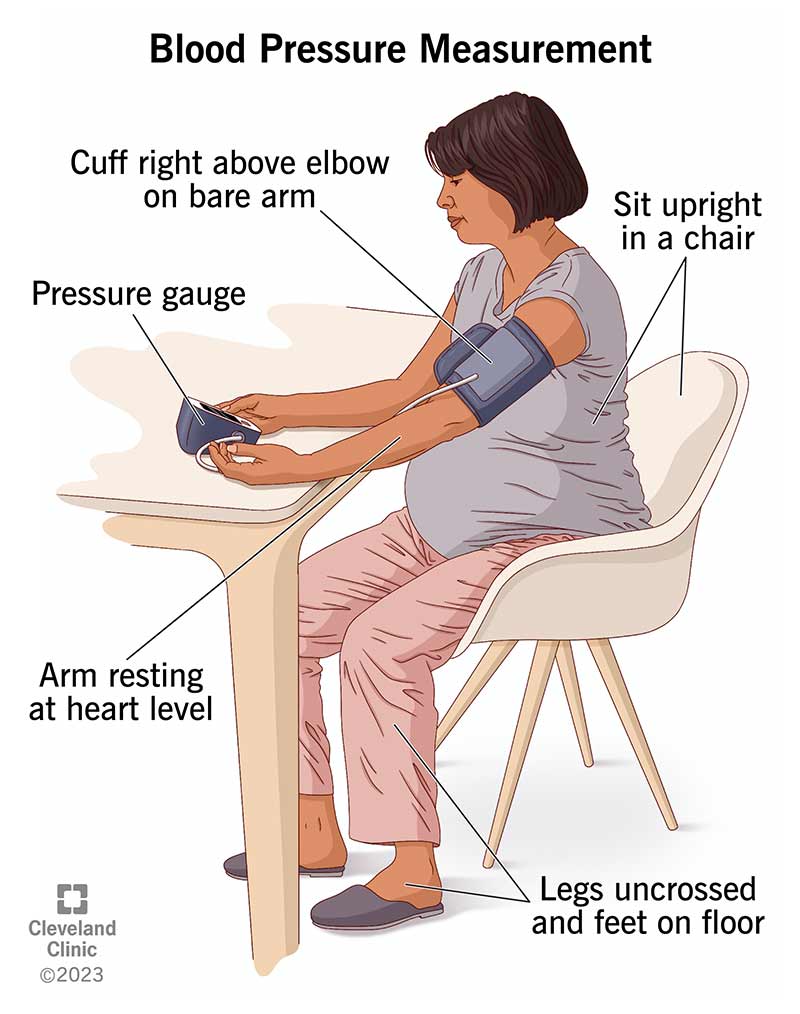Taking a blood pressure measurement allows you and your healthcare provider to know if you have high blood pressure. You can’t find out without checking it, but knowing the right way to check it matters. Getting an accurate reading requires the right preparation. Automatic devices make it easy to take a blood pressure measurement at home.

Blood pressure measurement is a quick, noninvasive test to find out if your blood pressure is normal. You can do it at home or a healthcare provider might do it for you. It’s the only test that can tell you if you have high blood pressure, which often doesn’t have symptoms until it’s severely high. Having high blood pressure can put you at risk for cardiovascular (heart and blood vessel) diseases.
When you take a blood pressure measurement, it tells you how hard your blood is pushing against the insides of your arteries. These are the blood vessels that deliver blood to your body’s tissues and organs so they can get oxygen and nutrients.
You can take a blood pressure measurement every day, but you should take it at the same time each day. For example, you may take it every morning at the same time and/or every evening at the same time.
Taking a few days’ worth of blood pressure measurements two weeks after starting a new blood pressure medicine can tell you if it’s working.
It’s also helpful to take blood pressure measurements a week before a checkup. This helps your healthcare provider know what a normal reading is for you at home. Some people have higher readings in their provider’s office (white coat syndrome). Other people get higher readings at home, so it’s good to have a mix of both in-home and in-office readings.
Your healthcare provider will check your blood pressure when they want to:
Advertisement
Cleveland Clinic is a non-profit academic medical center. Advertising on our site helps support our mission. We do not endorse non-Cleveland Clinic products or services. Policy
A blood pressure measurement device has a cuff that connects to a pressure gauge. When the cuff tightens around your arm, it temporarily blocks blood flow in that part of your arm. Loosening the cuff allows your blood flow to start again so you can find the minimum and maximum pressure in an artery.
You can get the most accurate reading by preparing for your blood pressure measurement in these ways:
You should be calm and quiet during your blood pressure measurement. Don’t talk or watch a video on your phone.
If you have an automatic blood pressure measurement device, follow these steps:
When you take a blood pressure measurement, you can take another one or two readings after waiting a minute between them.
Healthcare providers sometimes take a manual blood pressure measurement using a stethoscope and a blood pressure cuff.
They’ll follow these steps:
Often, providers will use an automatic machine to take your blood pressure measurement.
After a blood pressure measurement, you (or your provider) remove the cuff. You can go about your daily activities without any side effects from the test.
When the blood pressure cuff gets tight around your arm, you may feel uncomfortable. But the test only takes a minute and the tightness lasts a shorter time than that.
Advertisement
You’ll know your results right away. You’ll get two numbers:
You may record these as the first and second numbers with a slash between them, like 120/80. Results are in millimeters of mercury (mmHg).
Blood pressure readings can be low, normal or high.
Different age groups and illnesses (like recent stroke) might mean that your personal blood pressure goal is different from the typical adult levels. It’s important to work with your primary care doctor, cardiologist, nephrologist or whoever’s primarily managing your blood pressure to make sure you know your personal blood pressure goal.
One high blood pressure reading doesn’t mean you have high blood pressure.
To diagnose you with high blood pressure, your provider will need two or more high readings from separate visits. And they’ll use a lot of data points over time.
If your provider confirms that you have high blood pressure, they can prescribe medicine for you. Many different types of medications can treat high blood pressure. Your provider will use your medical history to help choose one that works for you. Some people with high blood pressure need to take two or three different pills to manage their blood pressure.
In addition to or instead of taking medicine, you may need to make changes to your daily life, such as:
If you get a high reading, wait and check again. If you keep getting high readings, contact your provider. Call right away if your numbers are in the hypertensive crisis range.
Get immediate help if your numbers fall in the hypertensive crisis range and you’re having symptoms like:
If your blood pressure is too low, it’s also important to seek medical attention. Some symptoms of low blood pressure include:
A note from Cleveland Clinic
Blood pressure measurement is a useful tool that can help your provider assess your health. Knowing how to take your blood pressure at home can give you the freedom to check it at your convenience. A blood pressure measurement can give you peace of mind if your results are good. It can also alert you to a possible need for treatment for high blood pressure, which has no symptoms. Don’t panic if you have one high reading. It takes more than that for a diagnosis.
Last reviewed on 06/13/2023.
Learn more about the Health Library and our editorial process.
Advertisement
Cleveland Clinic is a non-profit academic medical center. Advertising on our site helps support our mission. We do not endorse non-Cleveland Clinic products or services. Policy